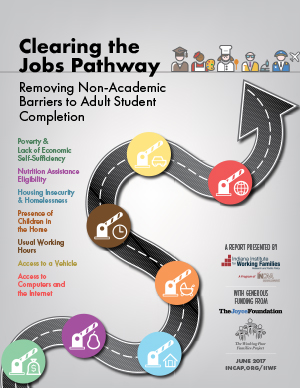Clearing the Jobs Pathway:
Removing Non-Academic Barriers to Adult Student Completion
 Executive Summary Executive Summary
In order to reach the state’s workforce and economic goals, Indiana needs leadership to better align resources for adult students and to remove barriers that stand between them and post-secondary education and training programs. The state has made progress in tailoring academic and training programs to workforce demands and made steps toward incentivizing those programs with financial aid. And yet, too many of the would-be students who need these programs most never take the first step because their path is blocked by non-academic barriers. Many more start but stop or drop out permanently before completing degrees and credentials that would benefit their families and Indiana’s economy. A few examples:
- More than 1 in 3 Hoosiers live below economic self-sufficiency, but even more (over 40 percent) adults pursuing post-secondary education and training cannot afford basic costs, compared to 29 percent of those not in training.
- Food insecurity hits adult students and their families hard, but while 26.8 percent of adult students may be eligible for nutrition assistance, only 20.2 percent of these students actually receive it.
- Housing Insecurity and Homelessness: Affordable housing is a barrier for would-be adult students, many of whom are low-income. 43.9 percent of Indiana renters spend 30 percent or more of their income on rent and utilities on housing and utilities, a major risk factor for housing insecurity. Across the Midwest, 48 percent of community college students are housing insecure, and 12 percent are homeless.
- Child care is the largest cost for working families, and the cost and lack of access prevents many new parents from starting training programs. The attending rate for adults with children under 5 is only 8.3 percent, but is 31.4 percent for those with kids ages 5-17 (school-age).
- Hours worked: 47 percent of adult students work full-time on top of school and family responsibilities, and a full 82.3 percent work at least 1 hour per week. Putting the work/study/family ratio out of balance puts completion at risk.
- Lack of reliable transportation: Only 2.9 percent of adults attending post-secondary programs did so without access to a vehicle. Without reliable access to a vehicle, it’s extremely unlikely for adult students to attend and complete.
- Increasing necessity of internet access: Only 8.5 percent of adults attending post-secondary programs did so without home internet access, which is now often required for both online and traditional coursework.
To meet these challenges, Indiana needs leadership from the very top of state government to align policies, break down agency silos, and ensure accountability for resources and outcomes for adult students.
JUNE 2017
Sources
- U.S. Census ‘Percent of Renter-Occupied Units Spending 30 Percent or More Of Household Income on Rent and Utilities’ 2015 American Community Survey 1-Year Estimates
- Goldrick-Rab, S., Richardson, J., & Hernandez, A. Hungry and Homeless in College: Results from a National Study of Basic Needs Insecurity in Higher Education. Wisconsin HOPE Lab. (2017)
For a full list of sources referenced in this report, please see the footnotes throughout the PDF document.
Related Resources
Policy Brief: Central Indiana Public Transit and Self-Sufficiency
- Reliable regional public transit would create savings for low-income families and expand economic opportunity.
- OCTOBER 2016 | Download the PDF
Policy Brief: Supportive Services for Indiana's Adult Learners
- Without supportive services, barriers like family obligations, child care, transportation, and misaligned school and work schedules will continue to stand in the way of Indiana's education completion and workforce development goals.
- MARCH 2015 | Download the PDF
Policy Brief: SNAP Asset Limits
- For Hoosiers that depend on Supplemental Nutrition Assistance Program (SNAP) benefits, the program's asset limits disincentivize savings, which is a critical step toward self-sufficiency.
- NOVEMBER 2015 | Download the PDF
|